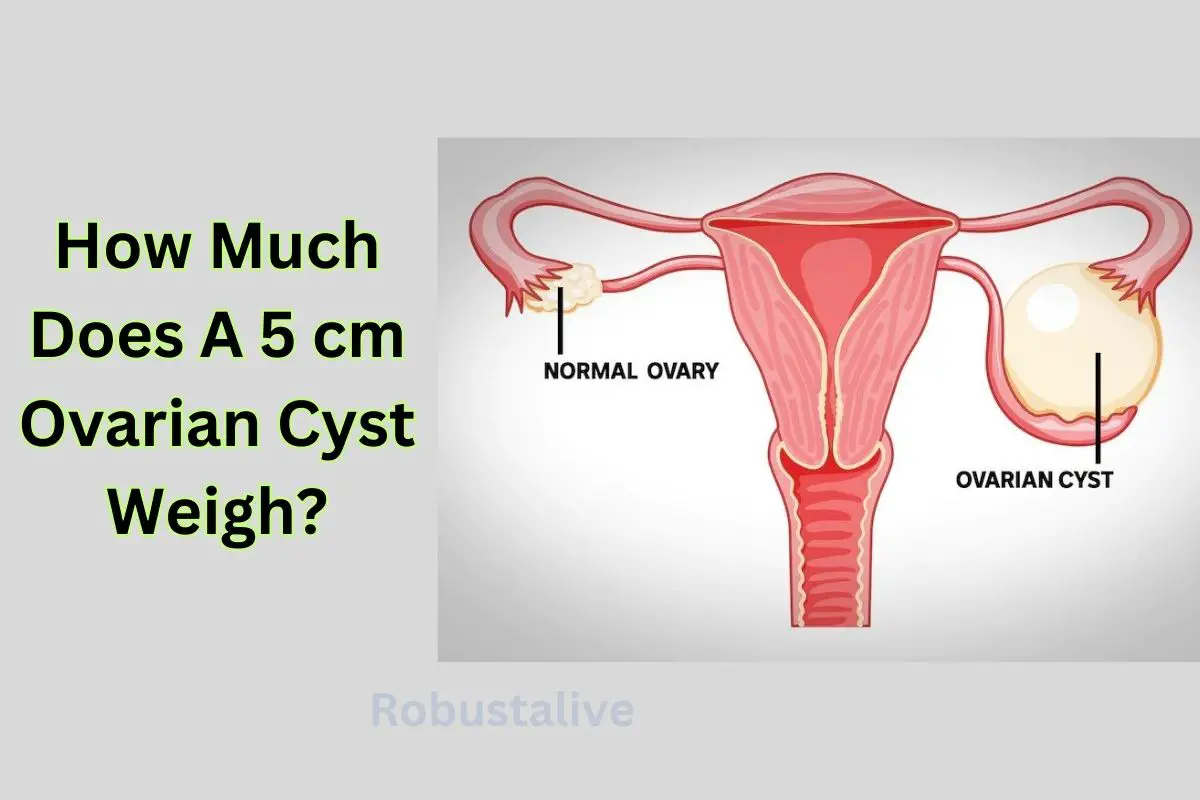How Much Does A 5 cm Ovarian Cyst Weigh?

It’s quite common for women to suffer from ovarian cysts in their lifetime. Most of this happens in the later stages of their life. In some rare cases, these cysts may show up earlier. These cysts can range in weight and size.
But how much does a 5 cm ovarian cyst weigh?
Cysts in the ovaries resemble fluid-filled sacs. The size and composition of an ovarian cyst determine how dangerous it is. A cyst’s weight varies with its size and makeup. The volume of a 5 cm cyst helps us to calculate its weight. A 5 cm ovarian cyst that is packed with fluid may therefore weigh up to 65.449 grams.
Join us on this journey to find out the ways to calculate the weight of an ovarian cyst, its severity, and available treatment options.
How Much Does A 5 cm Ovarian Cyst Weigh
Ovarian cysts, which can form on or inside the ovaries, resemble sacs packed with fluid. The size can vary from extremely tiny cysts that are frequently invisible to bigger cysts that are several centimeters. Cysts that are 5 cm in diameter are regarded as somewhat big and may need medical treatment. However, they can still be rather common and benign.
An ovarian cyst’s weight is determined by its volume. Which is calculated based on its size and form. It’s significant to remember that the cyst’s content and density can both affect its weight. For instance, a cyst filled with fluid (serous cyst) is often lighter than a cyst filled with solid (dermoid cyst). A combination of solid and fluid (complex cysts) will weigh more.
We can calculate the estimated volume of a 5 cm cyst using the formula for the volume of a sphere. It will provide us with a rough idea of the weight. V = (4/3)r3, where V is the volume and r is the radius, is the formula for a sphere’s volume.
The radius of a 5 cm cyst would be 2.5 cm (or 0.025 m), as it is half the diameter. We may estimate the volume as follows by entering this value into the volume formula:
V = (4/3)π(0.025)³
V = 0.000065449 m³
From this point on, we must take into account the cyst’s density, which might change based on its composition. A fluid-filled cyst often has a density that is comparable to water. It’s around 1 gram per cubic centimeter (g/cm3) or 1000 kilograms per cubic meter (kg/m3).
We may calculate the weight by multiplying the volume by the density. Here we will assume the cyst is fluid-filled, and use the average density:
Weight = Volume × Density
Weight = 0.000065449 m³ × 1000 kg/m³
Weight = 65.449 grams
A 5 cm ovarian cyst that is packed with fluid may thus weigh around 65.449 grams. Keep in mind that this is only an estimate. Cyst’s specific characteristics may affect the weight of the cyst.
Which Ovarian Cyst Size in Centimeters Is Most Dangerous
Size is only one factor in determining how harmful an ovarian cyst is; there are other factors as well. However, difficulties may be more likely with ovarian cysts that are bigger, often reaching 5 cm or more. These size cysts have the potential to be painful, and uncomfortable, and interfere with regular ovarian function.
Additionally, bigger cysts may be more likely to twist or rapture. The patient might experience internal bleeding and excruciating pain. And need urgent medical attention. An ovarian cyst’s risk is not just dependent on its size, but also on the symptoms it exhibits.
A rough guideline for ovarian cyst sizes and their level of risk is provided in the table below:
| Size of The Ovarian Cyst | Risk Factor |
| Less than 2 cm | Generally thought to be less harmful. These cysts are functional ovarian cysts and go away by themselves. Monitoring on a regular basis could be advised. |
| 2-5 cm | Low to moderate risk. While the majority of cysts in this range are still regarded to be harmless and common. If they persist or get bigger, they may cause symptoms and need medical treatment. In-depth observation and follow-up are frequently advised. |
| 5-10 cm | Higher level of threat. These cysts have the potential to cause pain and discomfort. Cysts can interfere with ovarian function. Complications including cyst torsion or rupture are more likely to occur. In general, medical assessment and management are indicated. |
| Bigger than 10 cm | Big cysts carry a higher risk of complications. Significant symptoms from these cysts might include excruciating pain and strain on nearby organs. Complications like twisting or rupture are quite likely to occur. These kinds of cysts can require surgical intervention. |
What Size in cm Is A Normal Cyst
A normal cyst is often regarded as tiny if it is less than 2 cm in diameter. These tiny cysts, which are frequent throughout a woman’s menstrual cycle, are mainly functional ovarian cysts.
Functional cysts often occur as a result of normal ovarian follicle growth. They disappear on their own without generating any noticeable symptoms or necessitating medical attention. It may be advised to undergo routine monitoring to make sure the cyst disappears and doesn’t get bigger.
The definition of a typical cyst size might vary. Therefore it’s vital to remember that each instance should be assessed by a healthcare provider.
What Cyst Size Requires Surgery
The need for surgery is determined by a number of variables. Such as; the cyst’s characteristics, the patient’s symptoms, and the existence of any alarming traits. Cysts greater than 5 centimeters in diameter are considered risky.
Especially, those with alarming traits including solid components, asymmetrical forms, fast development, or lingering symptoms may need surgery. However, whether surgery is required ultimately depends on the knowledge and assessment of the medical practitioner.
While some cysts might develop slowly over months or even years, others can grow very quickly. The type of cyst, hormonal changes, and individual traits are only a few examples that might affect the growth rate.
Functional cysts, frequently go away on their own after a few period cycles and may not develop much. On the other hand, some cysts, such as cystadenomas or dermoid cysts, have the capacity to enlarge over time. Tracking the development and features of ovarian cysts is essential for deciding the best course of action.
Does Ovarian Cyst Cause Weight Gain
Usually, ovarian cysts do not directly contribute to weight gain. But occasionally, certain ovarian cyst types might alter the hormonal balance, which may unintentionally cause weight changes or bloating.
For instance, the illness known as polycystic ovary syndrome (PCOS) is characterized by several tiny ovarian cysts and hormonal abnormalities. Due to insulin resistance, elevated androgen levels, and altered ovarian function, PCOS can result in weight gain.
Larger ovarian cysts may also be physically uncomfortable. They could impact eating habits or physical activity levels and consequently affect weight.
Can Ovarian Cysts Be Treated without Surgery
Yes, depending on their size and severity, Ovarian cysts are frequently treatable without surgery. The majority of ovarian cysts, especially functioning cysts, go away on their own over time without any help. When a cyst is not that big and not causing noticeable symptoms, a medical expert may advise taking a “wait-and-see” strategy with routine ultrasound or other imaging methods monitoring. But this wait-and-see rule might not be applicable for larger cysts with more complications.
Self-Care Advice for Women With Ovarian Cysts
Self-care routines may be quite helpful for ovarian cyst patients in symptom management and general well-being. It can aid with pain relief, promote mental well-being, and improve general health. This quick guideline offers tips on how ovarian cyst-afflicted ladies may take care of themselves:
- You can reduce ovarian cyst pain and discomfort by using a heating pad or warm compress to the lower abdomen. To avoid burns, use a moderate temperature and stay away from skin-to-surface contact.
- Maintain a balanced diet and frequent exercise to enhance overall health. Ovarian cysts may not be immediately treated by changing one’s lifestyle. It might enhance overall well-being and potentially improve symptom management.
- Ample water consumption can enhance overall health by ensuring optimum hydration. Additionally, it can help the body’s fluid balance, which might lessen the discomfort brought on by ovarian cysts.
- Ovarian cyst management can be emotionally taxing. Share your experiences, worries, and feelings with friends, family, or support groups. Support from others emotionally may be very helpful in managing the disease.
- Observe any variations in the ovarian cyst-related pain, discomfort, or other symptoms.
Frequently Asked Questions (FAQs)
-
What Is The Main Cause of Ovarian Cysts?
Functional cysts, often form as a result of typical menstrual cycle processes. These cysts develop when an ovarian follicle either fails to release an egg or does not disintegrate after doing so. Pathological cysts are not associated with the menstrual cycle and are brought on by aberrant cell development. They may appear both before and after menopause. The cells that produce eggs or the cells that line the outside of the ovary are where pathological cysts originate.
-
Can Ovarian Cysts Stop Periods?
Yes, ovarian cysts can interfere with menstrual cycles and affect menstrual patterns. The regularity and timing of menstrual cycles can be affected by functional ovarian cysts and cysts linked to PCOS. Ovarian cysts may cause missing or irregular periods and changes to the length or intensity of menstrual blood.
-
Can I Get Pregnant with An Ovarian Cyst?
Yes, you can. Although an ovarian cyst may raise the risk factor and may compromise fertility, it does not always preclude conception. Cyst’s size, nature, and the person’s general health can have an effect on fertility.
Bottom Line:
In conclusion, it is difficult to determine the precise weight of a 5 cm ovarian cyst without knowing more about it. We may, however, offer a preliminary estimate based on broad assumptions to answer the question of how much does a 5 cm ovarian cyst weigh. According to the typical cyst density, a 5 cm cyst might weigh as much as 65.449 grams. In order to bravely fight this battle, a patient with an ovarian cyst must concentrate on general well-being. Follow your doctor’s instructions and make an effort to live a healthy lifestyle.





